
The United Kingdom has seen considerable advances in 5G during the past year, but access to this emerging technology continues to be uneven across countries of the U.K. Looking at Q3 2020, data from Speedtest Intelligence® and Ookla Cell Analytics™ reveals how 5G affected overall mobile speeds, which country had the fastest 5G and where access was lacking. We also shed light on which operator had the fastest 5G in the U.K. as a whole and in London, specifically.
5G is 518% faster than 4G in the U.K.
5G speeds in the U.K. far exceeded those on 4G during Q3 2020 with the mean download speed over 5G coming in 517.8% faster than median download speed over 4G. The U.K’s mean upload speed over 5G was 121.5% faster than that over 4G.
Scotland had the fastest 5G download speed
Scotland brought up the national average for 5G speeds in the U.K. during Q3 2020 with a 6.1% faster mean download speed than we saw in the U.K. as a whole. England was the second fastest country in the U.K. for mean download speed over 5G and Wales was third. While 5G download speeds were promising in Northern Ireland, the volume of data did not meet our rigorous sampling guidelines. We’ll be interested to see how speeds there develop as more users access the networks.
Three was the fastest operator for 5G in the U.K.
As we’ve previously reported, 3 was the fastest mobile operator over 5G in the U.K during Q3 2020 with a median download speed of 201.12 Mbps. EE had the highest percentage of 5G Time Spent (when subscribers’ 5G-capable devices are connected to 5G).
How operators in the U.K. are using spectrum for 4G
The distribution of low, mid and high spectrum bands is evenly spread across all mobile operators in the U.K. All four operators hold licenses in the 800 MHz frequency band, while Vodafone and O2 hold additional 900 MHz licenses — some of which are still used to support the legacy 2G and 3G services. Three and Vodafone hold 20 MHz each of the 1500 MHz supplemental downlink band 32, and all four operators hold 1800 MHz and 2100 MHz licenses. It’s worth noting that EE holds a massive 40 MHz contiguous slice in the 1800 MHz band and 20 MHz in the 2100 MHz band.
O2 holds an additional 40 MHz contiguous spectrum block in the 2300 MHz (TDD) band. In the 2600 MHz capacity band, O2 holds a single 20 MHz block, Vodafone holds two 20 MHz blocks, while EE operates on a whopping 50 MHz slice of spectrum.
Given the spectrum distribution in the mid- and high-capacity bands, and the increased proliferation of devices with modern chipsets capable of aggregating multiple LTE component carriers, it’s fairly easy to see why EE has been able to consistently deliver the fastest LTE speeds in recent years.
When it comes to 5G, all operators have deployed 5G non-standalone networks in the 3.5GHz to 3.6GHz band (n78). EE and O2 operate their 5G networks using 40 MHz slices, Vodafone holds a 50 MHz license, while 3 was able to secure a 100 MHz license during the 5G auction — the largest possible channel width defined for FR1 networks. Given the massive advantage over its 5G competitors, 3 is able to consistently deliver the fastest 5G speeds.
The upcoming Ofcom spectrum auction in early 2021 should offer additional capacity in the 3.6-3.8 GHz range as well as the 700 MHz band, which should enable much wider 5G coverage across the U.K. Devices capable of aggregating low and mid 5G spectrum bands are also expected in the first half of 2021, which should allow operators to efficiently roll out standalone 5G and deliver broader 5G coverage with even faster speeds and ultra low latency.
England has the majority of 5G deployments in the U.K.
The Ookla 5G MapTM showed 5G deployments in 199 cities or towns in the U.K. as of November 4, 2020. 5G was commercially available in 176 English cities, and there were 14 5G cities or towns in Scotland, five in Wales and four in Northern Ireland.
This compares with 29 5G cities in the whole U.K. at this time last year: 22 in England, three each for Scotland and Wales and one in Northern Ireland.
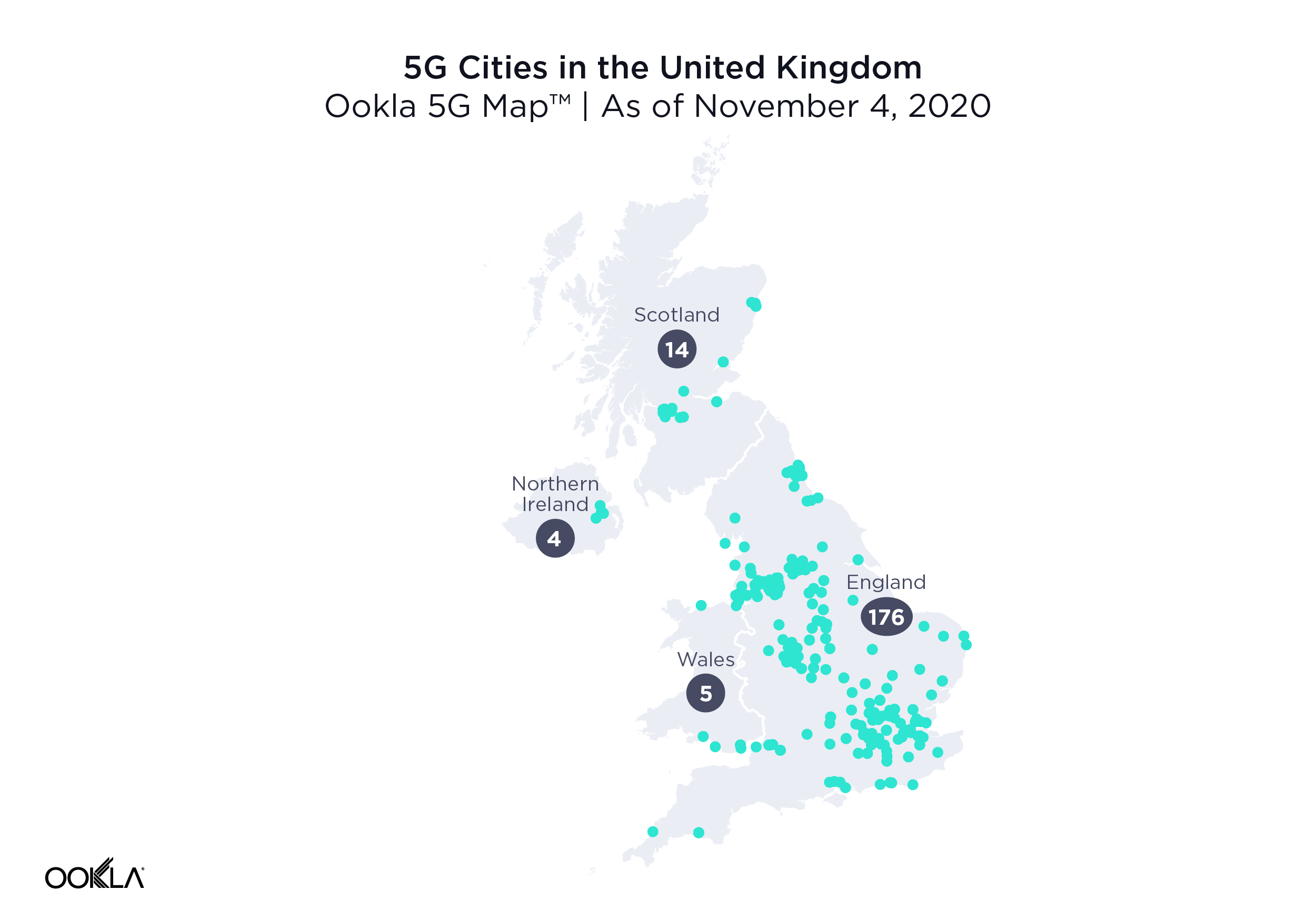
5G coverage varies by operator
Not all operators are deploying 5G cell sites in the same areas. Data from Cell Analytics measures where customers of each operator are accessing 5G and how strong that 5G signal is in each area. The following maps show 5G signal strength greater than -110 dBm for each operator.
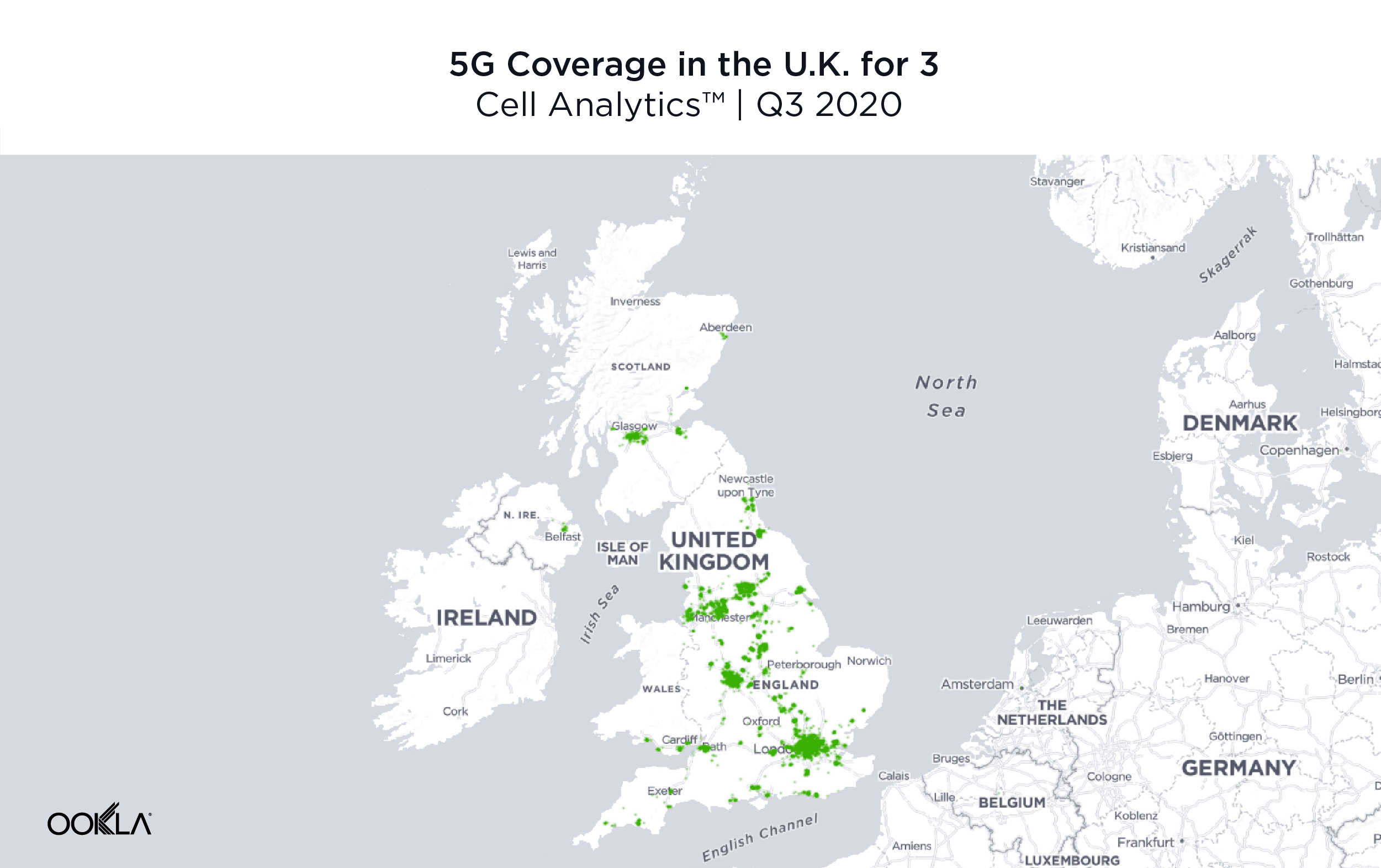
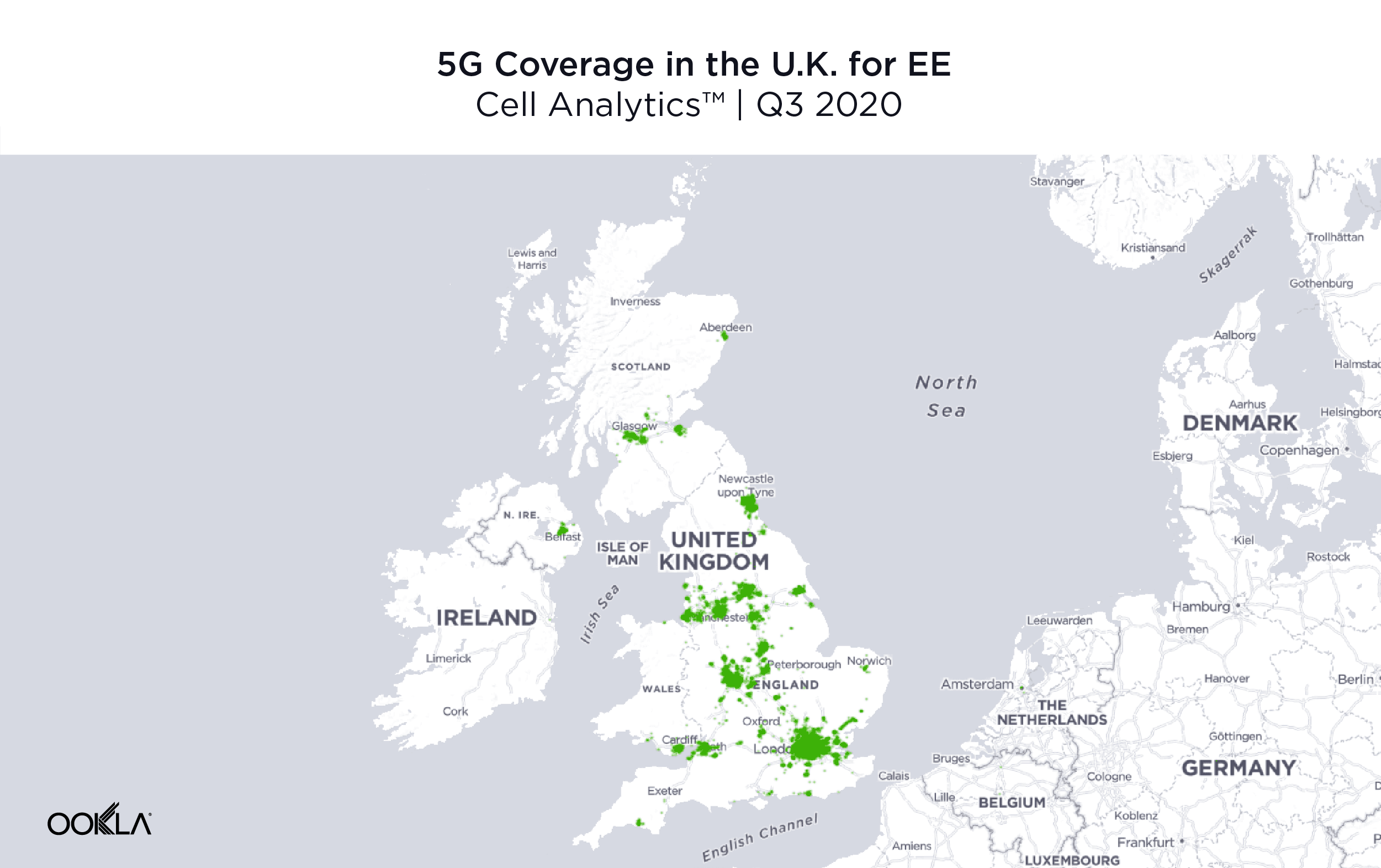
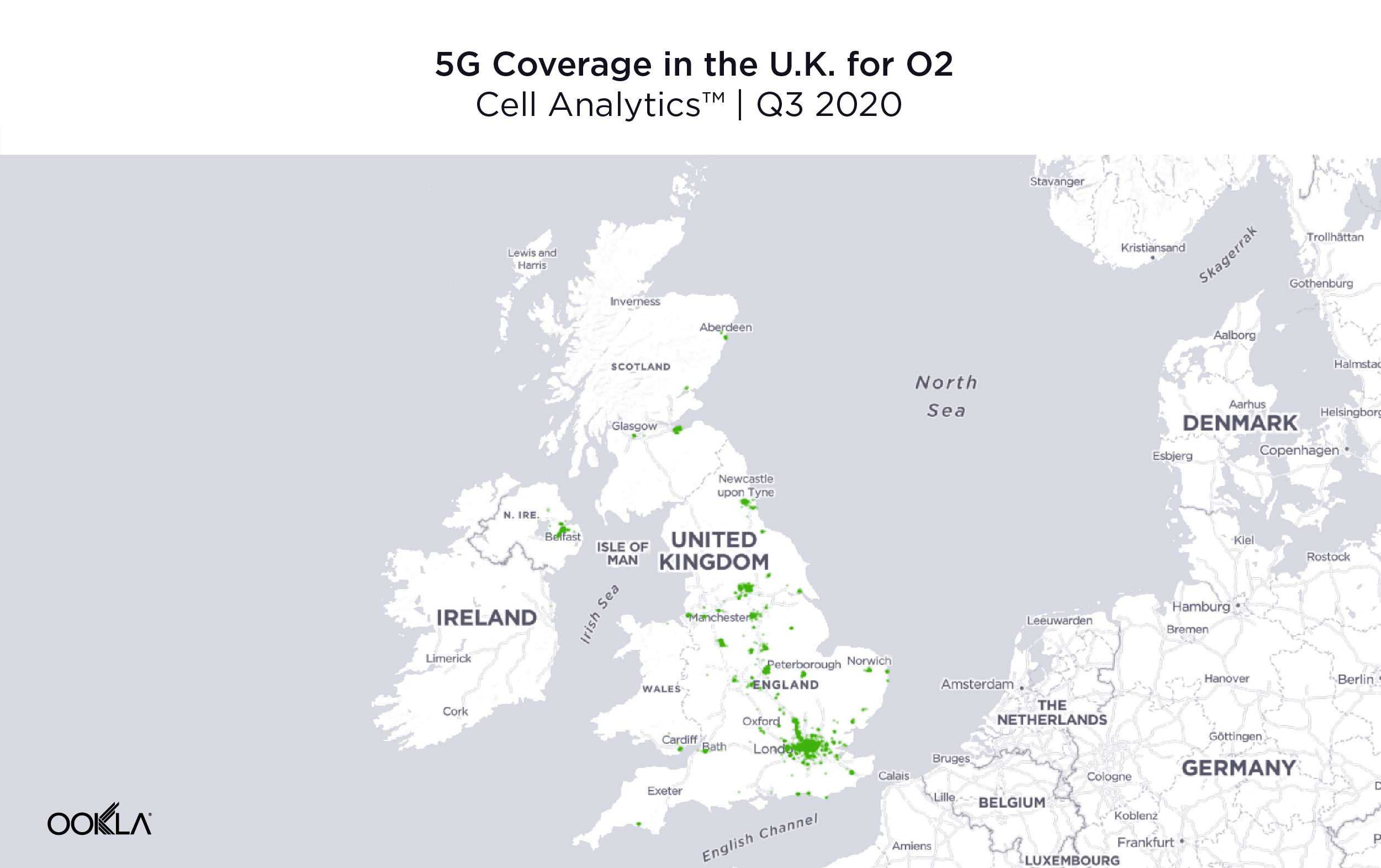
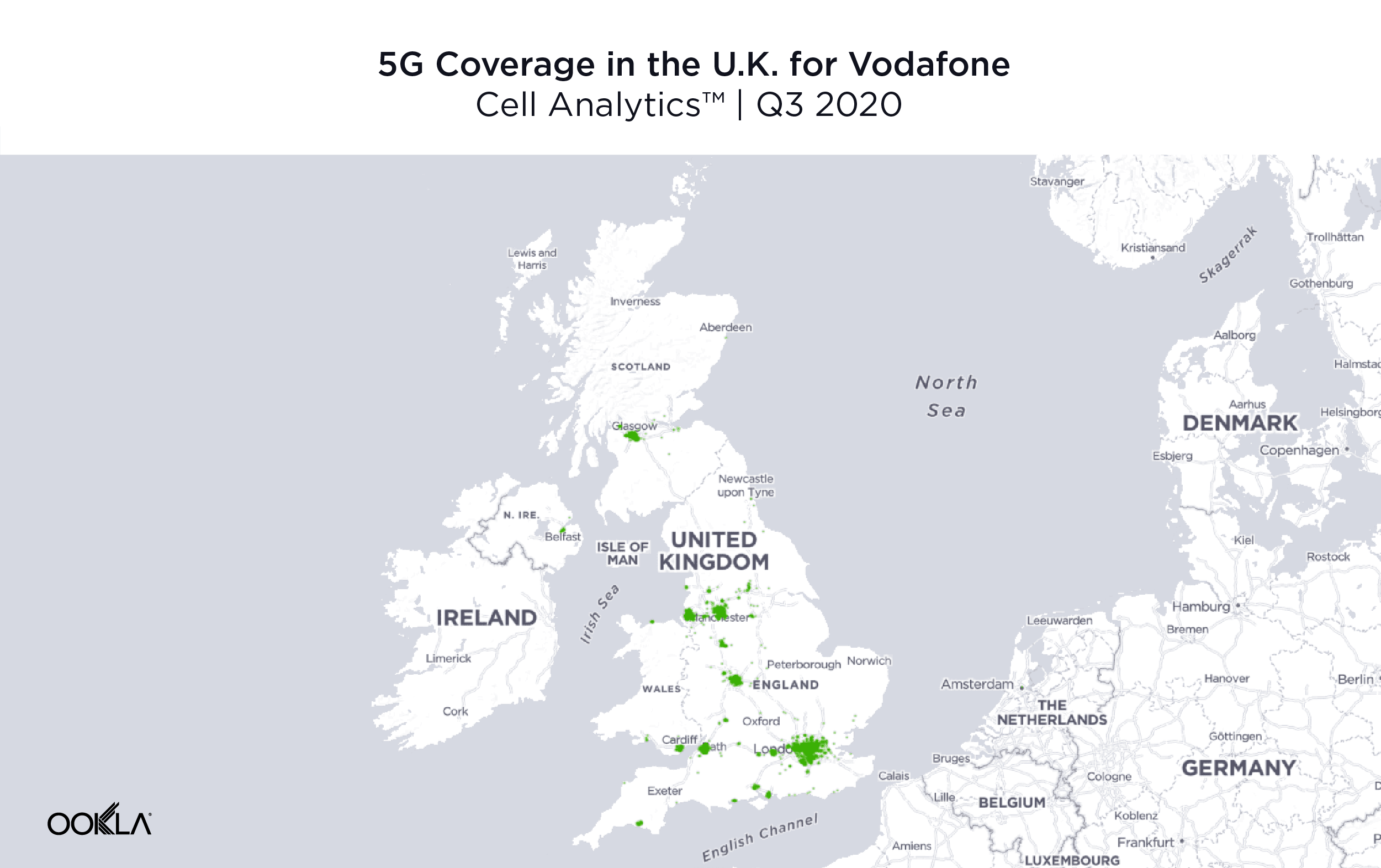
Three and EE show larger areas of measured coverage in most parts of the U.K., especially in and around Belfast, Birmingham and London. Vodafone shows a larger area of coverage around Glasgow and Newcastle upon Tyne. O2 shows a much smaller coverage area with clusters in and around Belfast, Leeds and London.
London’s 5G download speed was slower than the national average
London saw a mean download speed over 5G of 167.06 Mbps in Q3 2020, 10.6% slower than that in the U.K. as a whole. London’s median 5G upload speed of 22.92 Mbps was 7.2% faster than that in the U.K as a whole.
We’d like to be able to report which country’s capital city had the fastest 5G, but this technology is still emerging and there were not enough samples to responsibly determine a winner outside of London. We will be watching these markets carefully and will report back when there is additional information.
Three was the fastest operator in London
Three showed the fastest mean download speed over 5G among mobile operators in London during Q3 2020. O2 was second, an important distinction as many other data providers do not have sufficient samples to include O2 in their analyses. Vodafone was third and EE fourth.
We also analyzed the fastest 10% of Speedtest results over 5G for each operator to evaluate what speeds each network is capable of reaching at this time. Three had the fastest download speed in this category by far and EE led for upload speed.
England showed the highest time spent on 5G
We calculated the proportion of time that users with 5G-capable devices spent on 5G in the United Kingdom and found that England had the highest 5G Time Spent during Q3 2020 at 5.6%. This was higher than the average 5G Time Spent for the U.K. of 5.3%. Scotland had the second highest 5G Time Spent in the U.K. at 3.0% and Wales was third. As above, we have not included data for Northern Ireland because samples were too few. 5G Time Spent includes time spent on both 5G and 5G roaming.
While the rapid spread of 5G across the U.K. is exciting and speeds are promising, the benefits of 5G are spread unevenly across the nation — and time spent on 5G is still very low. We’ll be excited to see this technology expand and to analyze how 5G improves mobile performance across the U.K.
To learn more about the data behind this article and what Ookla has to offer, visit https://www.ookla.com/.







Sign up to receive our stories in your inbox.
Data is changing the speed of business. Investors, Corporations, and Governments are buying new, differentiated data to gain visibility make better decisions. Don't fall behind. Let us help.













Sign up to receive our stories in your inbox.
Data is changing the speed of business. Investors, Corporations, and Governments are buying new, differentiated data to gain visibility make better decisions. Don't fall behind. Let us help.





